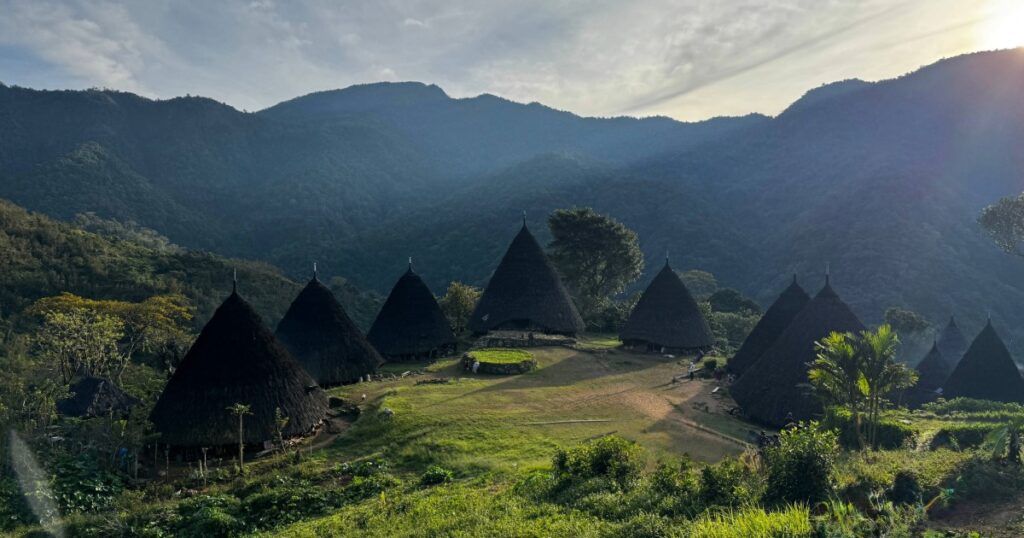As soon as I found out about Wae Rebo, I knew my trip to Indonesia wouldn’t be complete without making the trek. The price of getting there was a little daunting, but I went for it anyway and had such an amazing time staying a night in the remote mountain village. It was the highlight of my trip to Flores — even more so than the 3D/2N live-aboard boat around the Komodo Islands.
Here’s everything you need to know about Wae Rebo before you go, from a bit of history to a packing list.
This post may contain affiliate links. Bookings or purchases through these links generate a small commission for me at no extra cost to you. Thanks for your support!
About Wae Rebo
Wae Rebo is an isolated, centuries-old village in the mountains of Flores, Indonesia — the main island you’ll stay on to access Komodo National Park. The village is home to the Manggarai people. And while there’s no official record of how long it’s been there, oral history suggests 18 generations, or about 400-500 years.
There’s no road access, so getting there requires a two-hour hike. Perhaps surprisingly, in a country that’s predominantly Muslim (87% per Statista), this small community is Catholic. This influence can be attributed to some very determined missionaries during the Dutch colonial era (makes me wanna scream). But fortunately, even with that outside invasion, the community has held on tightly to its ancestral traditions and rituals.
The village is still largely off-the-beaten-track (literally) but you may have seen an image of its striking conical thatch-roofed houses called Mbaru Niang. I don’t really want to tell you too much, because learning about it while I was there was part of the fun!
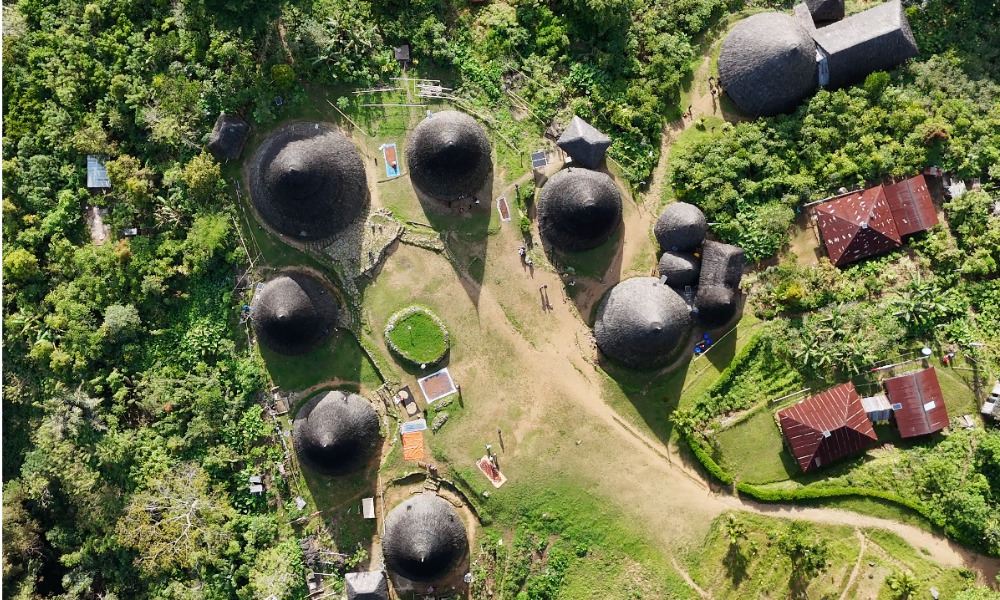
Aerial view of Wae Rebo
Getting to Wae Rebo village
The drive
You’ll likely leave from Labuan Bajo, the “Gateway to the Komodo Islands.” From there, it’s a four-ish-hour drive. The trip doubles as a bit of a safari, and we spotted water buffalo, monitor lizards, monkeys, and goats on the way. The ride was pretty comfortable with only 5 of us in the car plus a driver and a guide. So not too crowded.
Here’s how the drive to Wae Rebo was broken up with my tour:
- About 2 hours to an Alfamart (convenience store) for a quick rest stop & snacks if you so desire.
- Another 2 hours to a scenic lunch spot (meal included).
- 10-minute drive to a parking lot.
Oh, you thought that was the end? Nah. Then we took a 10-minute motorbike ride on the bumpiest “road” I’ve ever been on in my life. I’m not usually nervous on the back of a bike, but I was getting jostled around and holding on for dear life as we went up steep gravel inclines and over sketchy bridges.
It’s fun to reminisce once you make it to the other side, but in the moment? Stress. Not for the faint of heart.
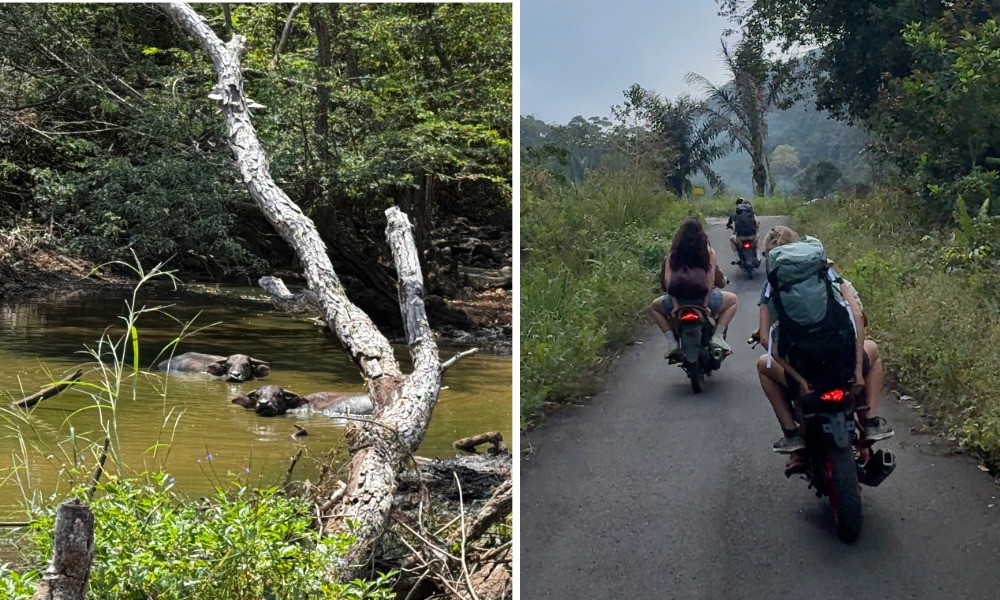
The motorbikes before the road became a death trap.
The hike
The hike to Wae Rebo itself isn’t that bad if you’re moderately fit. Even if you’re not fit, you can totally do it, it’ll just take you longer. The elevation gain is under 1,000 metres. Our guide joked that it usually takes people from Jakarta 4 hours and tourists from Australia just 2 hours. (Jakarta is incredibly flat.)
I love a good hike but I’m not running marathons or anything. And it took me and my group about 1hr 45 including stops, according to someone’s Strava. Regardless, the guide will match your pace, so don’t worry about it.
The first hour is the hardest, with lots of switchbacks. But then it gets easier with more flat sections, and you actually walk downhill into Wae Rebo.
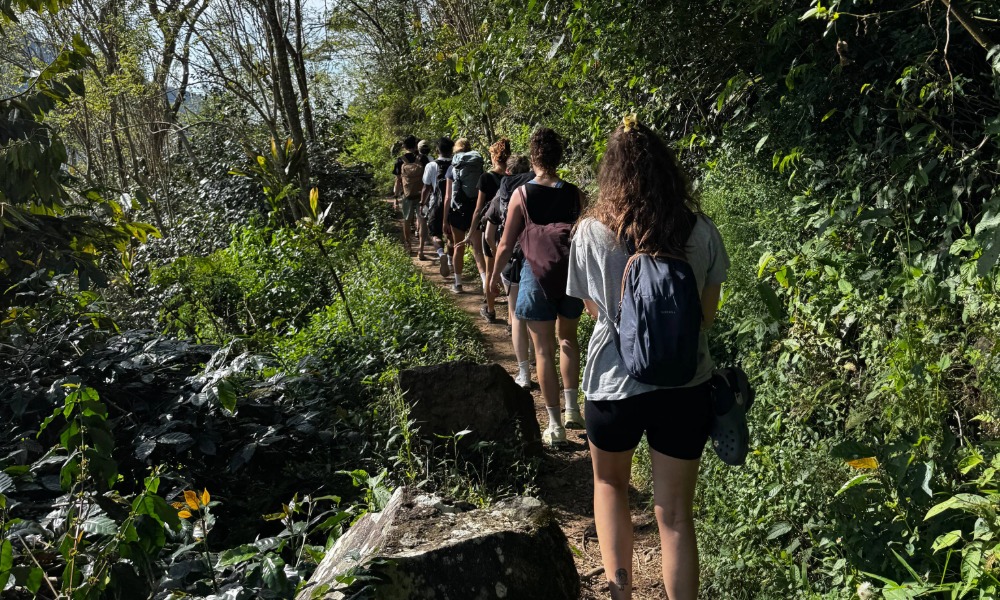
Arrival ceremony
Our guide told to keep our cameras away until we do the welcome ceremony. We were allowed to take photos on the hike up, but once we descended into the village we needed to wait.
The ceremony only took about 2 minutes. We sat opposite the chief on the floor of his house and he did a brief welcoming in his local language, and our guide translated afterwards. In short, the ceremony is to welcome us from our continents and honour the ancestors of the village.
We were then offered a tea or coffee and could freely explore the village and take pictures. Coffee is one of the main things they farm out here, but it was approaching 6 pm and I’m not really a big coffee drinker at the best of times, so I went with tea.
They served us dinner as a big group, all sharing family-style on the floor of the guest house. I don’t really know what happened, but my end of the table did not get enough food lol. I ended up having mostly rice for dinner and one egg. But that wasn’t the case for everyone. Def bring snacks just in case.
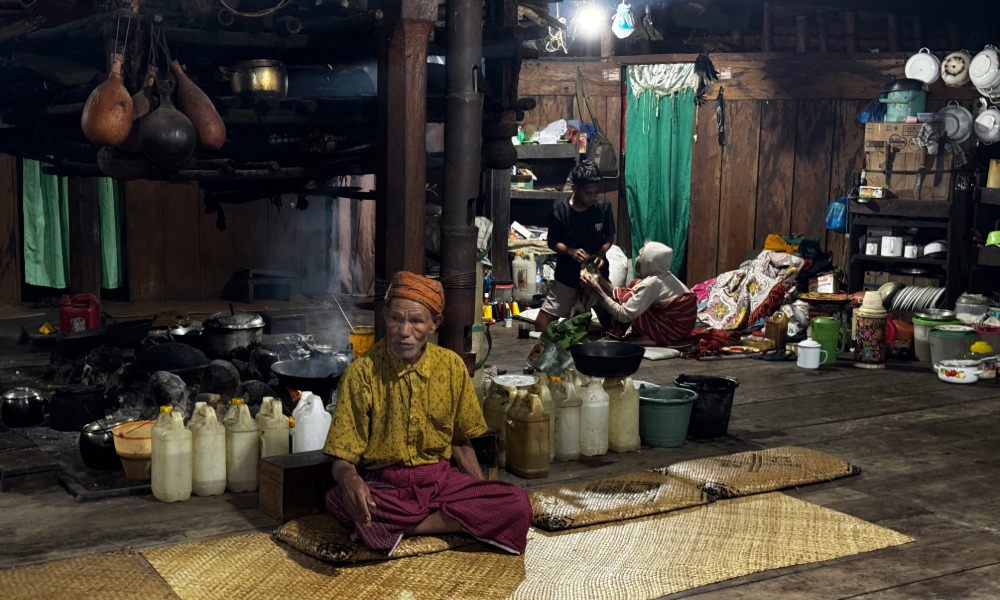
Sleeping at Wae Rebo
Sleeping arrangements
So one of the seven Mbaru Niang (homes) is now a guesthouse, but when there are more tourists than usual, villagers open their doors to let people sleep in the homes. My group was lucky, and we got to sleep in the chief’s house. This felt very special to me, but “lucky” is relative, as this meant no mattresses like they have in the guesthouse. One of the girls in my group did not like that lol.
It wasn’t exactly comfortable sleeping on the woven grass mats, and the blankets they gave us smelled like they hadn’t been washed, maybe ever.
But regardless of where you sleep, we’re in centuries-old wooden buildings. There’s no air con, no bug nets over the windows, and therefore: many bugs. I had to mind-over-matter the spiders literally just above my head. But for one night and for the plot? Perfect.
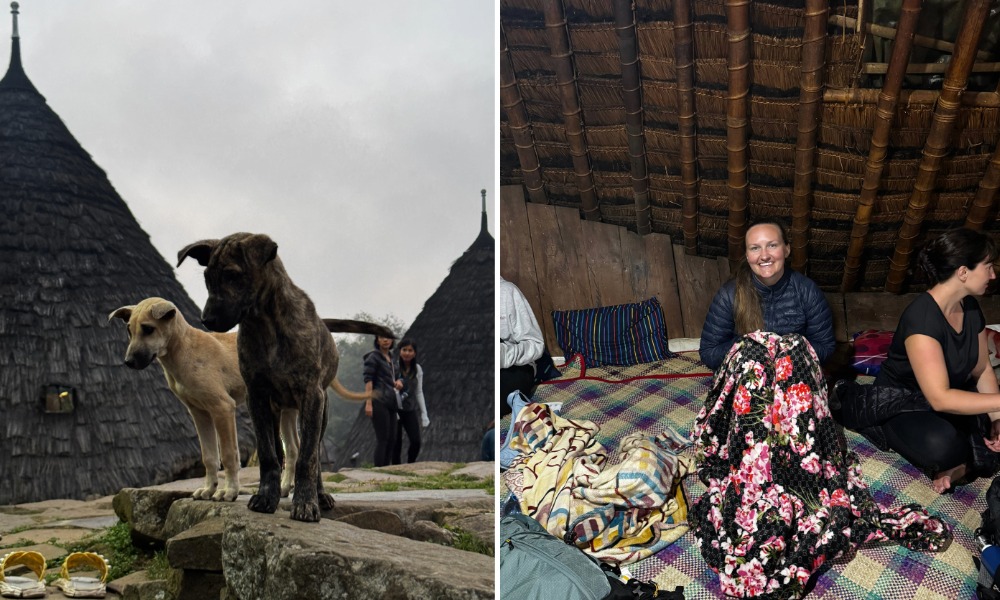
The village was also home to some very cute puppies — look but don’t touch.
Bathrooms
The bathrooms are very basic. They’re in separate buildings behind the Mbaru Niang, and just contain the essentials — running water and a squat toilet. (The one out behind the guesthouse had a Western toilet, but I’m not sure you’d want to sit on it.)
You need to bring your own toilet paper, but they do provide a little bin outside the toilet area. This is where I found the spiders the most threatening (and the largest). So I tried not to drink any tea or water after dinner. I did still have to get up in the middle of the night, so I highly recommend a headlamp.
Stargazing
The village has a few solar panels outside, which power a generator until 10 pm. Once the lights go out, you should take advantage of this extremely remote area where there’s absolutely no light pollution. We got super lucky that there was no moon and a completely clear sky, so we could see the Milky Way — hopefully you get the same!
Some people came with tri pods for long-exposure shots, which I’m sure turned out amazing. I just had my trusty iPhone.
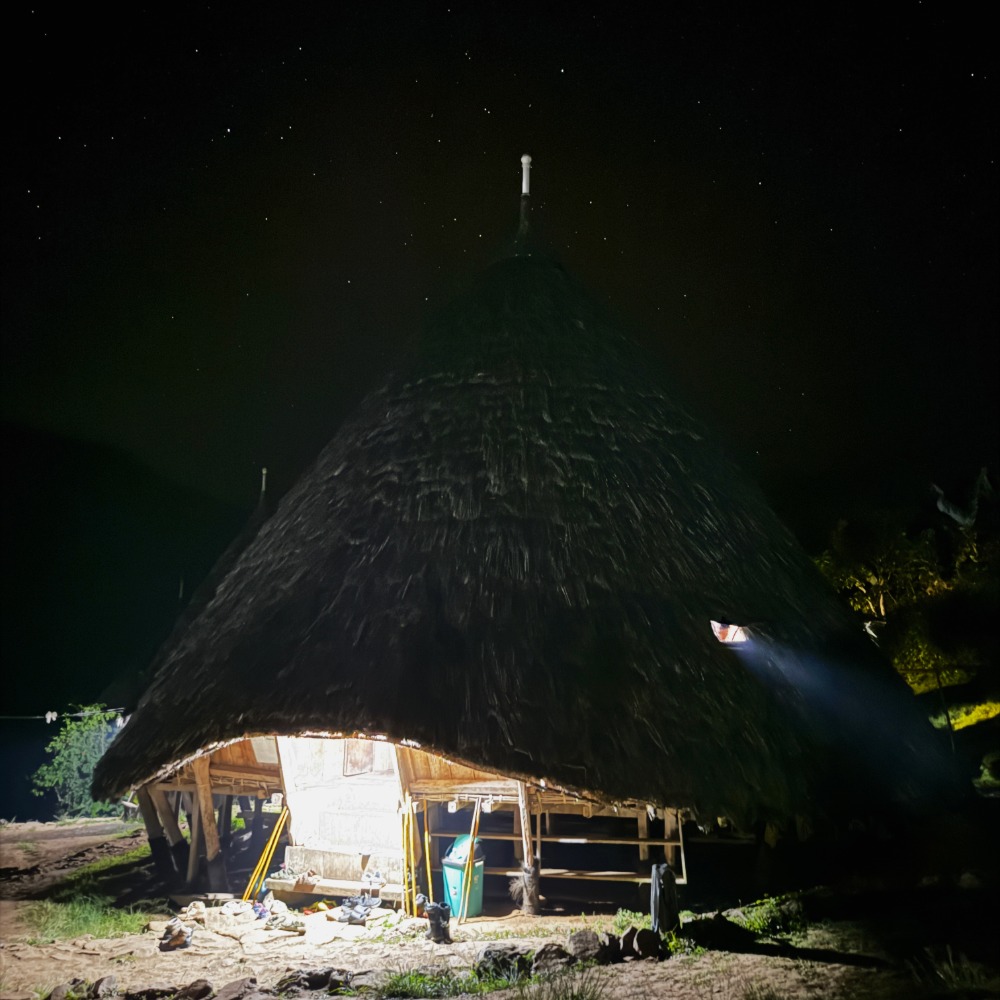
My best pics were actually before the lights went out
What to pack for Wae Rebo
It’s just one night, but you want to be prepared. Here’s what you should and should not pack for your visit to Wae Rebo:
- Small hiking backpack
- 2L of water. Enough for the hike up, teeth brushing + next morning.
- Trainers. Boots not required.
- Flip flops/jandals/thongs. Easier to slip on and off outside the houses.
- A headlamp. For bathroom trips or stargazing.
- Rain jacket/poncho. Even in the dry season, you never know.
- Warm pants. It gets cold at night, doubles as mozzie protection.
- Light puffer jacket or warm outer layer. It’s not freezing but cold enough — I was surprised. Maybe 10 degrees overnight in August.
- A travel towel. In case you want to shower or if it rains on your hike.
- Sleeping bag liner. Optional, but might be more comfortable to have your own blanket.
- Comfy hiking clothes for the trip there and back. There’s no dress code for the trail, but see the no-pack section.
- Socks. Bring an extra dry pair and/or thick pair for sleeping — my toes got cold.
- Sleepwear. Comfortable, covers knees and shoulders.
- Toiletries. Toothbrush, toothpaste, face wipes, clean water for brushing.
- Power bank. You can charge your phone but there are limited plugs and power goes out at 10 pm.
- Snacks. For the hike and for after dinner — there wasn’t really enough food.
- Card game. Really wish I’d had one!
- A tip for your guide/driver. Everyone in my group discussed and agreed to tip the same: 50,000 IDR.
- Cash. For snacks, tips, etc. It would be easy to forget since you’re leaving most of your stuff behind and everything is included. But definitely pack a little cash!
Do not pack:
- Alcohol. Not allowed. However, they may encourage you to try chewing betel nut instead.
- Barely there exercise gear. You want to be comfortable, but don’t be disrespectful. Knees are fine but don’t go for short shorts and do cover your shoulders. One girl in my group was wearing a very thin yoga shirt, braless, and they told her to cover up once we got to the top.
- Drone. Your guide (and all the other guides) will bring one. Our drone footage was pretty overexposed, so maybe if you’re a pro they’ll let you fly it or at least change the settings. But you don’t need to bring your own.
I tried chewing betel nut.
I’m easily peer-pressured and the locals invited me to partake. So what am I gonna do, say no? They wouldn’t tell me wtf it was until it was already in my mouth, and the mystery probably made me even more keen to try it. But I can’t say it was pleasant. Lots of people filmed me trying it — obviously getting a kick out of tourists’ reactions to this unfamiliar experience. And fair enough, it was very hard for me to play it cool lol.
It’s kind of like chewing tobacco (I think). Not in taste, but in effect. It gave me a bit of a head rush and made my mouth numb. 10 times worse than Sichuan pepper. Like, I was literally drooling against my will because I couldn’t really feel my mouth. It tastes gross, but YOLO.
The locals assured me it’s good for your teeth, but I think the opposite is true. Trying it once won’t do any damage. But you can tell when someone has been a frequent user because their gums and teeth are stained orange.
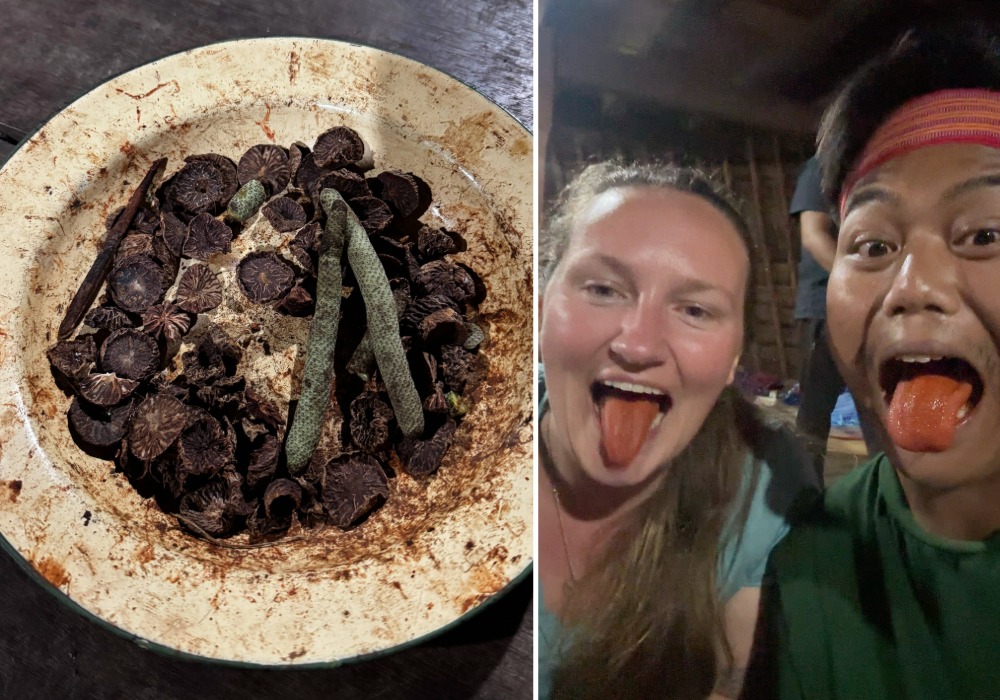
Is the price tag worth it?
Yes, Wae Rebo is an expensive excursion, but worth it.
Especially when you compare it to your daily spend stats in Indonesia, the 2,000,000 IDR (200 NZD, 100 EUR) will feel like a fortune. It’s even pretty expensive by home-price standards, actually.
But it’s also a super unique experience and a great way to explore beyond the usual touristed hotspots. Wae Rebo village is remote, authentic, and absolutely worth the extra money and effort to reach it.
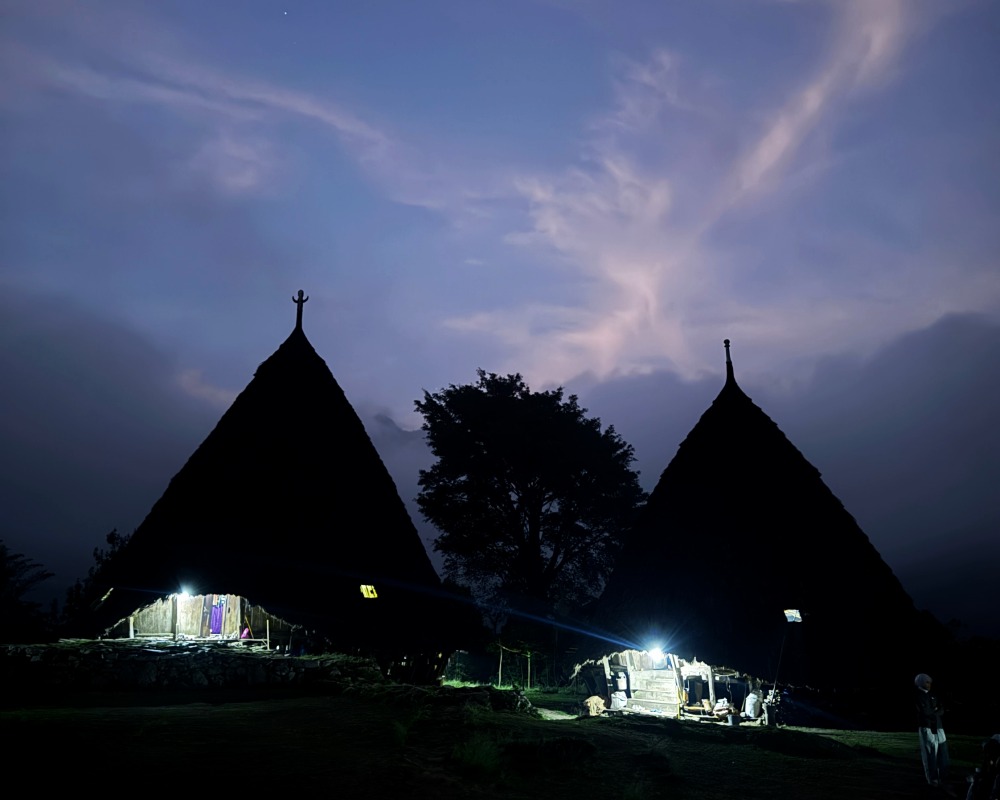
Is Wae Rebo legit?
I was worried it would be a bit gimmicky. Maybe the buildings would be 500 years old, but the village would just be there for show. Full of trinkets to buy*, maybe some people in traditional clothing for a photo op, but nothing more. It felt like a bit of a risk since it was so much money/effort to get there. But I was keen to check it out anyway, keeping my expectations low.
I was pleasantly surprised. People truly live in those homes. One is a dedicated guesthouse for tourists, with mattresses and bedding provided. The space at the centre of the circular building, which is where they’d have a kitchen in the other houses, acts as a dining area.
But there are only about 30 beds in the guesthouse. As I mentioned, this meant we got bumped to the chief’s house, which had some pros and cons. But ultimately proved to me that locals live in this house. I don’t think they’d have the 94-year-old grandmother sleeping in there just to impress the tourists. She was up coughing all night and boosting around early in the morning to make coffee.
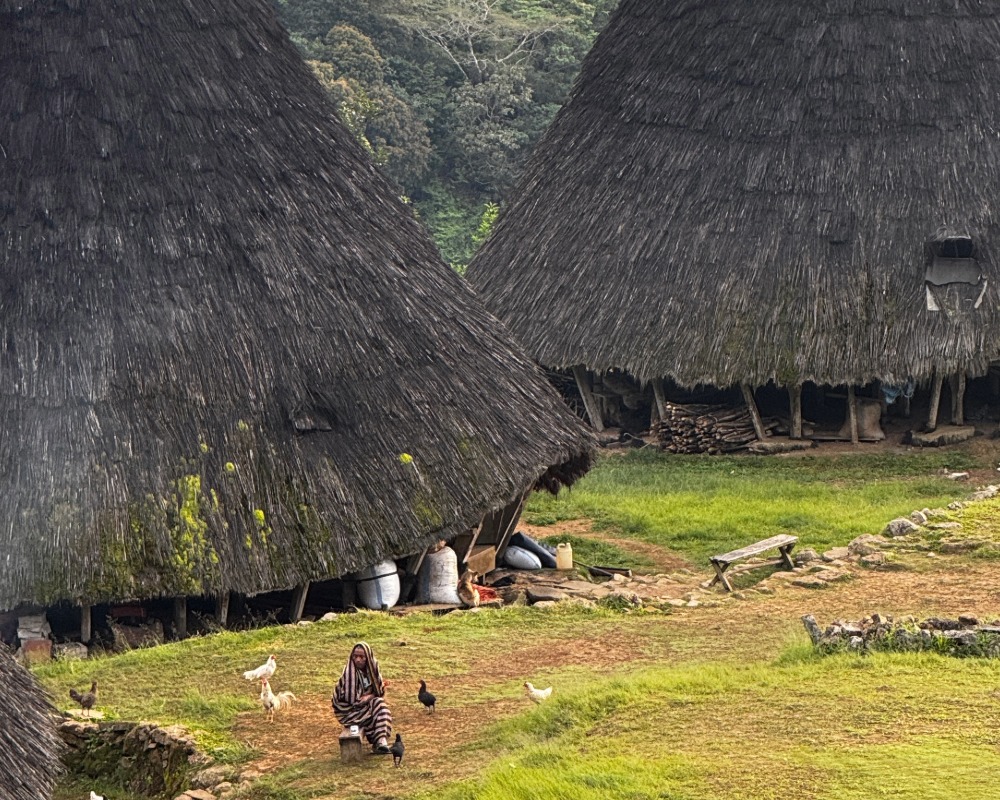
Yes, the tourism has become a significant source of income for the village, but they’d be living there whether we made the trek or not.
* There was a little wall with local coffee beans, woven sarongs, and bracelets to buy in the guest house, but they were never forced on us.
How to book your Wae Rebo trip
Booking a tour
I searched high and low for the best pricing, but I don’t think it’s really possible to visit the village (responsibly) for under 2,000,000 IDR.
I booked my Wae Rebo tour through Seaesta Komodo Hostel & Hotel, where I was staying — it cost 1,850,000 IDR. (Note: pretty sure you can’t book through them unless you’re a guest tho.)
Other girls I met on the hike all booked through Green Rinjani and paid 1,900,000 IDR, so that pricing seem fairly consistent.
However, companies on Get Your Guide were charging way more — around 2,500,000 to 3,200,000 IDR. But then I also saw someone in a Hostelworld group chat say she found a private tour for 1,300,000… I just don’t think that’s possible. There will definitely be hidden costs with that. I spent an afternoon asking tour companies around Labuan Bajo, did some haggling, and the 1.85m I paid through my hostel was still the cheapest I found.
If you’re looking for activity inspo, I do generally recommend downloading the Get Your Guide app. (The Wae Rebo trips were just weirdly expensive in this case.) If you end up booking something, make sure you use my 5% discount code: RUNAWAYWITHME5
Going on your own
It might feel more cool and intrepid to figure it out on your own, but to be honest, I think it’s a bit rude.
For one, you’re showing up at the village without warning, and you’re expecting to stay the night. You know there are no hotels. So you’re just going to show up and be like, give me food and a bed? Imagine if we all did this? I also will point out again that there was not enough food. And maybe that’s because they can only cater for as many people as they know are coming.
Secondly, you’re taking money away from the local guides. I’m all for simplifying and saving money where you can, and this activity is definitely expensive. But guiding is how some people make a living.
I even saw some people skip the motorbike ride from the parking lot to the trailhead. This was perhaps the most insane part. It costs a few bucks for those guys to drive you in. By taking the bike, you’re putting money into the community and not being another obstacle they have to avoid on an already treacherous road.
Maybe there’s some other logic for why you’d want to go to so much extra effort to skip the guides, but I don’t really get it.
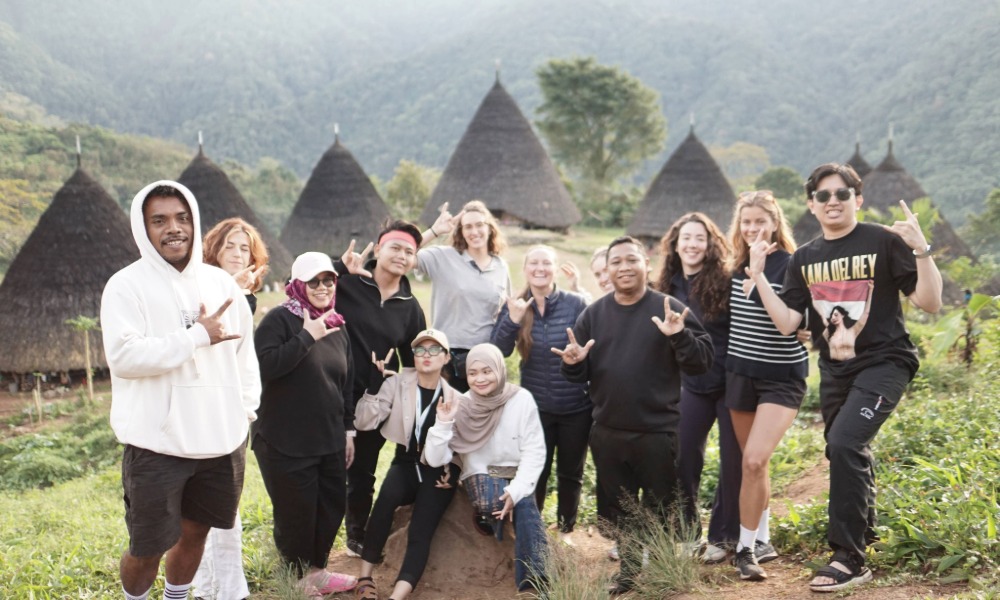
The W is for Wae Rebo
And beyond the sort of ethical side of things, there are some downsides for you, the traveller.
A couple that showed up without a guide had to sleep in the related village down the hill — not in one of the Mbaru Niang. Takes some of the magic away, doesn’t it?
They also joined our welcome ceremony and were asked for some money for food/lodging before it started. It made me physically cringe to watch them like, ask how much and then fumble around in their fanny packs to pull out enough money and ask for change. If you just go with a tour group, it’s smooth sailing and you won’t feel like you’re imposing.
I had fun meeting the other like-minded travellers on my trip!
Before your trip, don't forget
Get an eSIM for Indonesia before you arrive!
While Wae Rebo is too remote for any cell service, an eSIM will come in handy for the rest of your trip. Saily is my favourite budget-friendly option.
They also have regional packages if you’re backpacking around Southeast Asia, or global plans if you’re on a big world tour.

